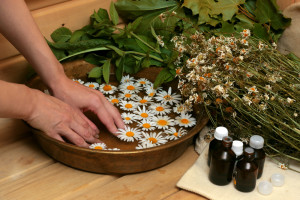Written by Greg Arnold, DC, CSCS. An herbal remedy of chamomile and linseed oil taken four times per day for one week significantly improved the symptoms of dry mouth in the seventy-four patients who suffered from xerostomia.
 Although a seemingly trivial liquid, saliva is a very important substance for our health 1. It supports the integrity of the oral cavity, helps maintain a healthy bacterial composition of our mouth and even helps digest food when we eat 2. The onset of chronic diseases such as type 2 diabetes, high blood pressure, autoimmune diseases like lupus and even prescription medications can decrease proper saliva secretion in the mouth, a condition called xerostomia 3-5.
Although a seemingly trivial liquid, saliva is a very important substance for our health 1. It supports the integrity of the oral cavity, helps maintain a healthy bacterial composition of our mouth and even helps digest food when we eat 2. The onset of chronic diseases such as type 2 diabetes, high blood pressure, autoimmune diseases like lupus and even prescription medications can decrease proper saliva secretion in the mouth, a condition called xerostomia 3-5.
A 2016 study 6 involved 74 patients (68 males, 6 females) aged 60 to 72 who were diagnosed with xerostomia. They received either a conventional saliva substitute (cellulose-based substitute from Farmacias Ahumada = 37 subjects) or an herbal substitute (37 subjects) consisting of 1 gram of dry chamomile flowers and 30 grams of linseed oil. Both substitutes were consumed in 2 milliliter servings, 4 times per day for 1 week. After a 1-week washout period, the subjects switched groups for another week.
Before and after the study, the subjects underwent a ‘saliva test’. During the 3-hour test period (8 am to 11 am) they provided as much saliva as they could into a cup. They also completed a questionnaire on their xerostomia.
After 2 weeks of supplementation, the following results were observed:
| Herbal Group | p-value | Conventional Group | p-value | |
|---|---|---|---|---|
| Sensation of dry mouth | 16.7% decrease (7.20 to 6.07) | 0.003* | 15.4% decrease (6.47 to 5.48) | 0.002* |
| Sensation of thick saliva | 18.2% decrease (6.28 to 5.14) | 0.028* | 15.1% decrease (5.04 to 4.28) | 0.121 |
| Sensation of burning tongue | 24.9% decrease (4.66 to 3.50) | 0.038* | 4.2% increase (4.47 to 4.66) | 0.582 |
| Needing to drink liquids to swallow | 10.4% decrease (4.93 to 4.42) | 0.839 | 28.9% decrease (4.61 to 3.28) | 0.019* |
| Sensation of difficulty in swallowing food | 35.9% decrease (5.19 to 3.33) | 0.001* | 12.4% decrease (4.47 to 3.92) | 0.216 |
*Statistical significance
When suggesting a mechanism for this improvement in the herbal group, the researchers pointed to the rich content of proteins, unsaturated oils, and fiber which “when wet, the lining cells of linseeds release great amounts of mucilage, forming a surrounding gelatinous capsule” 7. As for chamomile, the researchers pointed to the essential oil and flavonoids in chamomile that possess sedative, antispasmodic, anti-inflammatory and antimicrobial properties 8,9.
The researchers did admit that a weakness of the study was its short duration, so an evaluation for a long period of time is necessary to ensure the prolonged effectiveness of the herbal substitute. The lack of a placebo group could also have been seen as a weakness, since we don’t know how much of a placebo effect figured into the improvements in the two groups.
While concluding that “chamomile- and linseed-based saliva substitute was effective in relieving xerostomia symptoms in older participants of this study”, they recommend “Further prolonged studies including participants of both genders are necessary to evaluate the effectiveness of the chamomile and linseed saliva substitute in reducing the symptoms of xerostomia.”
Source: Morales‐Bozo, Irene, Ana Ortega‐Pinto, Gonzalo Rojas Alcayaga, Juan P. Aitken Saavedra, Olga Salinas Flores, Claudia Lefimil Puente, Carla Lozano Moraga, José M. Manríquez Urbina, and Blanca Urzúa Orellana. “Evaluation of the effectiveness of a chamomile (Matricaria chamomilla) and linseed (Linum usitatissimum) saliva substitute in the relief of xerostomia in elders.” Gerodontology 34, no. 1 (2017): 42-48.
© 2016 John Wiley & Sons A/S and The Gerodontology Association. Published by John Wiley & Sons Ltd
Posted January 31, 2017.
Greg Arnold is a Chiropractic Physician practicing in Hauppauge, NY. You can contact Dr. Arnold directly by emailing him at PitchingDoc@msn.com or visiting his web site at www.PitchingDoc.com.
References:
- Dawes C. How much saliva is enough for avoidance of xerostomia? Caries research. 2004;38(3):236-240.
- Brosky ME. The role of saliva in oral health: strategies for prevention and management of xerostomia. J Support Oncol. 2007;5(5):215-225.
- von Bültzingslöwen I, Sollecito TP, Fox PC, et al. Salivary dysfunction associated with systemic diseases: systematic review and clinical management recommendations. Oral Surgery, Oral Medicine, Oral Pathology, Oral Radiology, and Endodontology. 2007;103:S57. e51-S57. e15.
- Pijpe J, Kalk W, Bootsma H, Spijkervet F, Kallenberg C, Vissink A. Progression of salivary gland dysfunction in patients with Sjögren’s syndrome. Annals of the rheumatic diseases. 2007;66(1):107-112.
- Porter S, Scully C, Hegarty A. An update of the etiology and management of xerostomia. Oral Surgery, Oral Medicine, Oral Pathology, Oral Radiology, and Endodontology. 2004;97(1):28-46.
- Morales‐Bozo I, Ortega‐Pinto A, Rojas Alcayaga G, et al. Evaluation of the effectiveness of a chamomile (Matricaria chamomilla) and linseed (Linum usitatissimum) saliva substitute in the relief of xerostomia in elders. Gerodontology. 2016.
- Naran R, Chen G, Carpita NC. Novel rhamnogalacturonan I and arabinoxylan polysaccharides of flax seed mucilage. Plant physiology. 2008;148(1):132-141.
- McKay DL1 BJ. A review of the bioactivity and potential health benefits of chamomile tea (Matricaria recutita L.). Phytother Res. 2006;20(7):519-530.
- Orav A, Raal A, Arak E. Content and composition of the essential oil of Chamomilla recutita (L.) Rauschert from some European countries. Natural product research. 2010;24(1):48-55.
